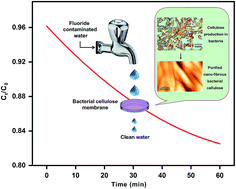An unprecedented bacterial cellulosic material for defluoridation of water†
Abstract
Anthropogenic and natural forms of fluoride have become a major problem worldwide in groundwater resources. Creation of affordable materials for removal of fluoride, a stable form of fluorine, is a challenging criterion to provide safe drinking water. Environmental friendly biopolymers scavenging fluoride from water that can function as a water purification cartridge without electricity can result in an efficient yet affordable water purification system. Here we show such bacterial cellulose materials reported to have nano-structural properties and a greater adsorption ability with reference to plant-derived cellulose strands, can perform efficiently in removal of fluoride from natural water. In this study, we show that this material can serve as a solution to remove fluoride traces even at the lowest concentration present in natural water resources. The fluoride removal capacity was monitored using a laboratory batch model, which was quantified using Zirconium–Alizarin Red S. Fourier transform infrared spectroscopy, and X-ray diffraction studies reveal the characteristic features of cellulose produced by five different bacterial isolates. This material can be used to develop an affordable water purifier in the form of 500 g cartridges which can purify natural water (≤10 ppm F−) upto 2500 L, sufficient per year for a family. The ability to extract nanostructured compositions from microorganisms has wide relevance for inexpensive adsorption-based water purification.


 Please wait while we load your content...
Please wait while we load your content...